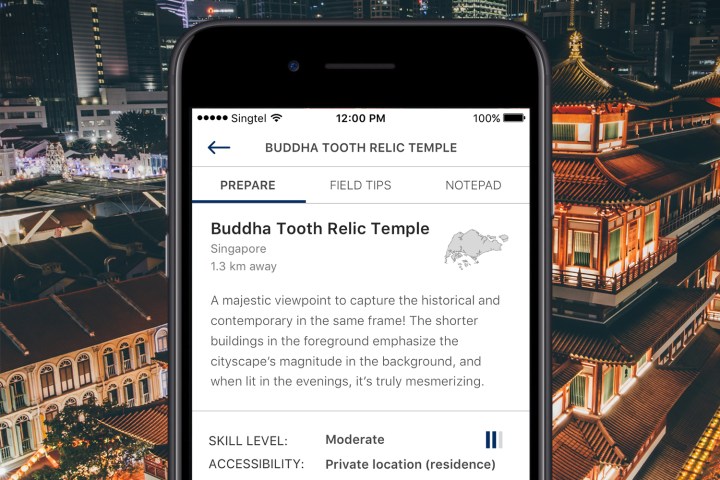
GPS-enabled cameras allow automated software to put photos on the map, giving photographers and travelers an idea of where to explore next. But automated programs will mix in those stunning landscapes with cat photos and duck-lipped selfies — leaving lots of digging left to scout out the best views. One startup is aiming to change that by curating locations from real, human photographers. Explorest is a new iOS photo-scouting app that mixes the best views with photography tips and tricks from local shutterbugs and influential Instagrammers. After launching in Singapore in July 2017, Explorest expanded to California on April 24.
Several apps and websites already suggest photo locations by pulling photos from the web and using the GPS metadata to show exactly where the view was shot. Explorest is different, CEO and co-founder Justin Myers explains, because the app is 100 percent curated, from the suggested locations to the best times to shoot and even how to get there. That means the app is filled with only pro shots — and pro recommendations.
The app, which officially launched July 17, 2017, for Singapore, now recommends locations in California. The company plans to continue expanding by inviting local photographers worldwide to contribute to the program. The start-up encourages photographers to help by sharing half of the app’s revenue with the contributors.
The second biggest way that Explorest differentiates itself from options like Streetography and Photo Hotspots is in the level of detail, Myers says, often listing information that isn’t easily accessible on the internet. For each location, Explorest lists the exact GPS coordinates and how far away that spot is from the user’s current location. While the program allows users to easily pull up directions inside Apple’s native Maps app with a tap, insight from the photographer on just how to get there is available, too, pointing out obscure locations and spots that require a bit of walking as well as noting whether it’s easier to hop on a subway or drive.
Along with how to get there, Explorest helps photographers plan by suggesting the best times to visit — including the “magic hour” times for the golden hour, blue hour, sunrise, and sunset — and what to pack. Real-time weather for the location is also integrated into the app. The exact photo specs are also listed, along with at least three technical or compositional tips from the photographer. The app also includes a list of recommended things to see and do nearby.
“Compared to other products, we personally vet every piece of information — our entire app is vetted,” Myers said. “We interview photographers before building location insights. The users can trust that the information is not only from local photographers, but accurate and something to depend on.”
The photo scouting app built by photographers is also designed to personalize the results to each individual user. At the first log-in, the program asks photographers a series of brief questions to determine their photo style and what they like to shoot. Based on those answers, the program will prioritize architectural locations to those photographers who choose architecture, for example. While the personalization is based on that initial series of questions, the program is a form of artificial intelligence which will continue improving personal recommendations the more the user interacts with the app.
Inside Explorest, users can search by keywords, view the closest locations or sort by genre or the newest locations. The app also saves locations and users can also mark which spots they’ve already visited and even take a photo or jot down notes in-app while there.
Myers founded Explorest with professional photographer and Instagrammer Michael Lax. After Lax realized how much time he spent searching the web and asking for in-person recommendations for new locations (sometimes only to miss the best shot time) the two partnered to develop a solution.
“One of the most common questions I come across on Instagram is, ‘where was this photo taken?’” Lax said. “To answer this, we’ve essentially built a digital location scout that allows people to quickly access a premier database of photo locations curated by locals who have insider knowledge about a given area. One of my favorite things about Explorest is that it can be used for so many purposes for photographers and travelers alike, including finding the perfect setting for an engagement proposal or simply wanting to experience the most epic views on vacation.”
For the California launch, the state’s locations will be unlocked for a limited time. Full access to all of the app’s features is available for $6 a month, or $30 a year from the App Store.
Updated on April 30: Added expansion to California.



